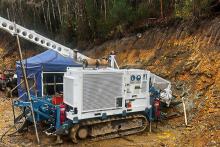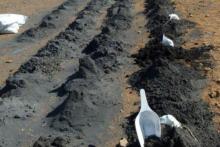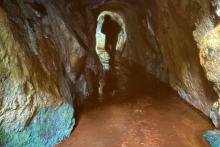Octava Minerals has landed some exceptional high-grade indium results up to 860ppm in re-analysed rock chip samples from its Sweeney’s prospect at the company’s Federation copper-zinc-silver project in western Tasmania. A fixed-loop electromagnetic geophysical survey has illuminated strong sulphide connectivity at the prospect, paving the way for imminent diamond drilling.


Octava Minerals has landed some exceptional high-grade indium results up to 860ppm by having a re-look at some old rock chip samples from its Sweeney’s prospect within the company’s Federation copper-zinc-silver project in western Tasmania. A fixed-loop electromagnetic (FLEM) geophysical survey has also illuminated strong sulphide connectivity at the prospect, paving the way for imminent diamond drilling.
The Federation project, spanning 121 square kilometres just 12km west of the town of Zeehan, sits in Tasmania’s storied mining corridor near historic producers like Rosebery and Renison, with ready access to hydro-power, roads and a variety of mineral processing hubs.
The Sweeney’s prospect, viewed historically as a greisen-style tin system hosted by non-conductive granite, has revealed a dual personality where disseminated tin mineralisation sits alongside steeply-dipping base metal sulphides.
Geologically, a greisen is typically a granite that has been altered by hydrothermal fluids, resulting in deposits of minerals that could be rich in tin, tungsten and lithium.
The sulphides at Sweeney’s throw other minerals into, or next to the greisen mix, including pyrite (iron), pyrrhotite (iron), sphalerite (zinc), chalcopyrite (copper), cassiterite (tin) and stannite (copper-iron-tin) minerals
Octava Minerals managing director Bevan Wakelam said: ”We are pleased to announce that the diamond drill rig is currently re-mobilising to site to commence drilling at Sweeneys. We look forward to the progress of the first drill campaign at Sweeney’s since Renison back in the late 1970’s. The results from the re-assay of grab samples for indium are extremely encouraging and confirm the multi-element value of the mineralisation at Sweeney’s.”
The re-assayed rock chips, which came from costeans above the main adit at Sweeney’s, have confirmed very high indium grades, smashing the 500 parts per million (ppm) laboratory upper grade limit to peak at 860ppm indium
Three other samples delivered one indium result of 820ppm, while the remaining two came in at 560ppm indium.
The same samples also returned elevated zinc to 27.5%, copper to 0.58%, silver to 434g/t, tin to 5.97%, and 0.92% antimony, offering a definitive indication of a multi-metal granite-related hydrothermal system.
To put the exceptionally high indium grades in context, the average crustal indium abundance hovers around 0.05–0.25ppm indium in continental rocks, with typical background levels in granites and sediments less than 1ppm indium, while economic thresholds in zinc ores rarely exceed 20–200ppm indium.
The indium hits at Sweeney’s - up to 3,400 times crustal norms – hint at a potential world-class enrichment, possibly occurring as chemical substitutions into zinc sulphide crystal lattices via coupled mechanisms that involve copper, indium and zinc.
Geologically, the prospect aligns with greisen-bordered vein systems where magmatic fluids from 360-420 million year old Devonian granites have interacted with 485 to 541 million year old Cambrian volcanics, driving sulphide precipitation.
While indium often ties to deep mafic-ultramafic sources in the crust, at Sweeney’s it appears to be a classic tag-along in tin-tungsten polymetallic greisens and volcanogenic massive sulphides (VMS), as seen in global analogues such as Bolivia’s Santa Fe district.
Complementing the chemistry, Australian Geophysical Surveys’ single-line fixed loop electromagnetic (FLEM) survey over Sweeney’s has detected robust responses demonstrating that EM can sniff out sulphides in resistive granite hosts where it has not been deployed previously.
The strike extent of the EM responses exceeds 65m, indicating strong continuity, however further resolution is not possible from the single line survey.
The company is mobilising a diamond drill rig to undertake Sweeney’s first modern drilling program since the 1970s, targeting open-at-depth semi-massive sulphides to follow up historic intercepts including a 23m run assaying 1.19% copper, 1.7% zinc, 121g/t silver and 1.17% tin.
Holes will be cased in preparation for running down-hole electromagnetic (DHEM) surveys to peer sideways up to 150m off the bore of each drill hole, while the company is also planning an airborne electromagnetics EM survey for early 2026 across the Federation project area.
Indium’s modern criticality, fuelling indium tin oxide (ITO) coatings for glass electronic screens, solar panels, AI data centres and defence optics, positions Octava’s Sweeney’s prospect as a strong strategic play amid the metal’s tightening global supply.
Octava’s prospect could become an intriguing and valuable fusion of greisen geochemistry with VMS vigour, delivering indium firepower and sulphide signals that scream untapped potential in Tasmania’s mineral heartland.
Is your ASX-listed company doing something interesting? Contact: matt.birney@businessnews.com.au












